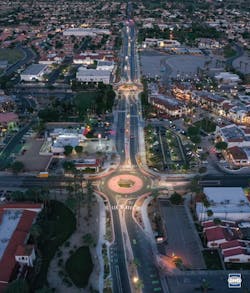By Lindsey Van Parys, Contributing Author
The award-winning La Quinta Village complete streets road diet project contributed significantly to the city's transformation. The project's goal was to establish a comprehensive and inclusive transportation system that would enhance the experience of living there, while also improving safety and accessibility.
La Quinta, Calif. faced several challenges that needed to be addressed before the project. The city was primarily designed around vehicular traffic, resulting in limited roadway crossings and frequent risky jaywalking. Safety concerns prevented many parents from allowing their children to walk or bike to school, and cyclists faced challenges due to inadequate infrastructure.
Existing bicycle lanes and sidewalks caused cyclists to ride on sidewalks or travel against traffic flow, posing risks to themselves and others. The traffic congestion before and after school hours affected local businesses and homes, with drivers resorting to illegal and dangerous practices such as using the shoulder or bike lane. The stress level for users was high due to fast-moving vehicles nearby, making it challenging to utilize these facilities.
Recognizing the need for change, La Quinta officials partnered with GHD Inc. to address these issues. GHD proposed a grand vision for the entire community, going beyond small improvements and securing $7.3 million in state funding for the transformation. This approach focused on making small improvements towards better multi-modal access as funding allowed, allowing the city to gradually implement the changes necessary for a more people-first community.
The La Quinta Village complete streets road diet project repurposed three roadway corridors to provide safe alternative methods of travel while maintaining vehicular capacity. By reducing four lanes to two and converting five signalized intersections to roundabouts, the project transformed heavily traveled, vehicle-centric corridors into pedestrian and bicycle-friendly complete street corridors. Additionally, the project added midblock crosswalks, separated sidewalks, buffered bicycle lanes, shared-use paths, and water quality features among other enhancements.
The implementation of roundabouts improved safety without compromising traffic operations. The project created safe and equitable connections to parks, schools, libraries, and more throughout the community. It not only focused on transportation improvements but also sought to enhance the aesthetics and environmental sustainability. Through placemaking, environmental design and landscape architecture, the project seamlessly integrated with the existing village landscape. Drought-friendly landscaping reduced installation costs, long-term maintenance, and water usage, while water quality basins and innovative landscape treatments improved drainage relief for the stormwater system and enhanced the natural environment.
The project's impact extended beyond transportation and aesthetics. Prior to the project, the community faced challenges related to health, air pollution, and limited alternative transportation options. With the implementation of complete streets, the project closed gaps in the alternative transportation network, providing safe and connected facilities for all users. By promoting walking and cycling, the project aimed to improve public health and reduce the prevalence of chronic diseases such as heart disease and asthma. Moreover, the improved traffic flow resulting from the roundabouts reduced vehicle emissions, contributing to improved air quality in the community.
Community engagement played a vital role in addressing the needs and concerns of the residents. Extensive efforts were made to involve the community and address their questions and fears at the onset of the project’s plans. Parents' concerns regarding the safety and accessibility of their children were specifically addressed through an innovative approach.
GHD created a fictional school-aged character named Rosita, who guided children and parents through the concepts and navigation of roundabouts in a short cartoon and comic book. This bilingual campaign educated children and parents about the project's changes and emphasized safe walking and biking practices. By alleviating fears and providing clear information, the community gained support and confidence in the project.
The success of the La Quinta Village complete streets road diet project set a precedent for similar initiatives in the city. The transformation of the community has been astounding. People of all ages now have improved access to amenities and enjoy the redesigned infrastructure.
La Quinta and its residents were ecstatic when their project was recognized nationally, receiving the National Public Works Association's Project of the Year Award in 2022. This prestigious accolade highlighted the innovation, dedication, and positive impact the project had on the community.
Through determination, innovation, and a touch of creativity, La Quinta underwent a remarkable change that not only improved public safety and accessibility, but also enhanced the overall quality of life in the community. It transformed a predominantly vehicle-centric city into a people-first community, where walking and cycling are safe and enjoyable modes of transportation. The project's environmental benefits, including reduced vehicle emissions and improved air quality contribute to a healthier and more sustainable future.
La Quinta Village is now more than just a roadway; it is a vibrant and inclusive way of life. The success of this project serves as an inspiration for other communities seeking to create livable, connected, and sustainable environments. By prioritizing the needs of residents and investing in comprehensive transportation solutions, cities can unlock the full potential of their communities and create places where people thrive. This project stands as a testament to the transformative power of visionary planning, effective collaboration, and a commitment to building a better future for all. R&B
Lindsey Van Parys, P.E., is a GHD Principal and Project Director, as well as a registered civil engineer in multiple states who holds a certificate in Traffic Collision Investigation.



